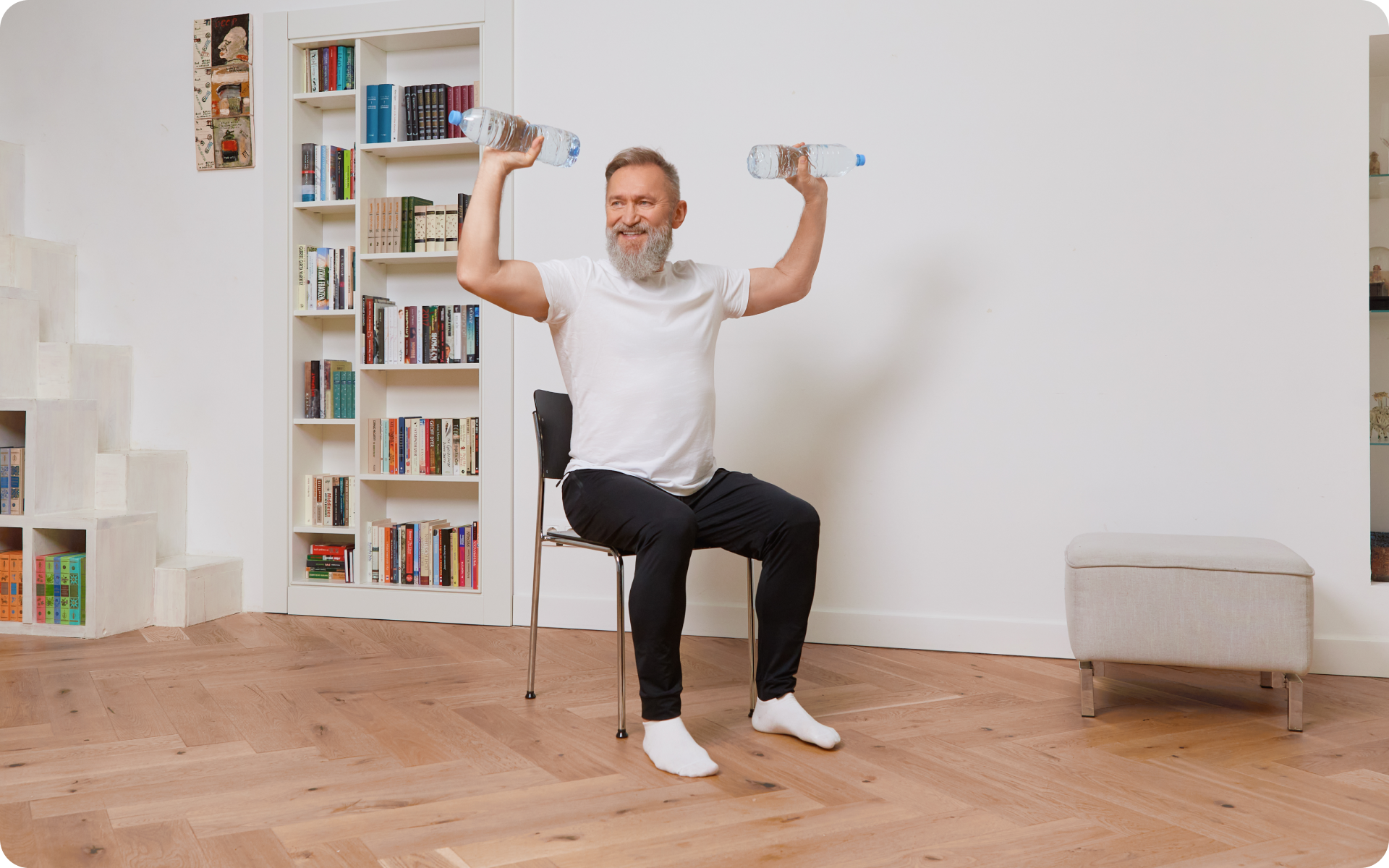Have you ever wondered if there’s a better alternative to the traditional work chair? With an estimated 86% of American workers sitting long hours at their desks, it’s no surprise that sedentary lifestyles have been linked to numerous health issues, including obesity, heart disease, and musculoskeletal disorders (6) (12). In fact, research shows that sitting for more than 8 hours per day increases the risk of premature death (11). If these alarming facts have caught your attention, it’s time to consider an occasional solution that could revolutionize your workspace and improve your well-being: the yoga ball chair. In this article, we’ll explore seven incredible benefits of using a yoga ball chair and how it could transform your work experience, boost your productivity, and promote a healthier lifestyle. You may end up saying goodbye to your conventional work chair and embracing the potential of the yoga ball!
What’s A Yoga Ball Chair?
A yoga ball chair, also known as a stability ball chair or exercise ball chair, is an innovative seating option that replaces the traditional office chair with a large, air-filled rubber ball.
The primary purpose of a yoga ball chair is to engage your core muscles, improve posture, and promote overall well-being while you sit and work at your desk.
Yoga ball chairs come in various sizes, typically ranging from 45 cm/17.7 in to 85 cm/33.5 in diameter, to accommodate different heights and body types.
Is A Yoga Ball Chair Good For You?
A yoga ball chair promotes active sitting by engaging the core muscles, which helps maintain proper spinal alignment and reduces strain on the lower back (4). It encourages subtle movements, enhancing circulation and muscle engagement throughout the body.
As a result, users may experience improved posture, increased core strength, and reduced discomfort associated with prolonged sitting.
To understand how a yoga ball chair can be good for you, it’s essential to explore the mechanics of sitting, the biomechanics involved, and the effects on muscles and joints.
Sitting involves various joints and muscles in the body, with the spine, pelvis, hips, knees, and ankles all playing crucial roles.
When you sit, your body weight is distributed across these areas, and the muscles surrounding them work together to provide stability and maintain posture.
In a traditional chair, the biomechanics of sitting often lead to a sedentary posture that puts strain on the spine, neck, and lower back (2).
Slouching, crossing legs, and leaning forward are some common habits that contribute to poor posture and discomfort (5). These positions can cause muscle imbalances, leading to pain and potential long-term issues.
The unique design of a yoga ball chair encourages active sitting, which reduces the risk of developing muscle imbalances and chronic pain (8).
Rather than being confined to one static position, it allows for subtle movements that keep your core engaged and promote good posture. This helps relieve tension in the spine and improves muscular balance throughout the body.
Read More: Embrace Relaxation With Chair Yoga For Hips
What Are The Benefits Of Sitting On A Yoga Ball Chair?
Sitting on a yoga ball chair offers several advantages compared to traditional chairs, positively impacting your health, posture, and overall well-being. Here are some key benefits you may experience by using a yoga ball chair:
1. Improved Posture
A yoga ball chair engages your core muscles, promoting better spinal alignment and reducing the tendency to slouch (4). This improved posture can help alleviate discomfort and prevent long-term issues related to poor sitting habits.
2. Increased Core Strength
As you maintain balance on the yoga ball chair, your core muscles are continuously engaged, leading to increased strength and stability in the abdominal and lower back regions. A strong core can help reduce the risk of injury and improve overall physical performance (1).
3. Reduced Lower Back Pain
Sitting for extended periods on a traditional chair can cause strain on the lower back (3). The yoga ball chair encourages natural spine alignment and reduces pressure on the lumbar region, helping to alleviate lower back pain (10).
4. Enhanced Circulation
The subtle movements required to maintain balance on a yoga ball chair stimulate blood flow throughout the body, improving circulation and reducing the risk of developing blood clots associated with prolonged sitting.
5. Increased Energy And Focus
Active sitting on a yoga ball chair keeps your body and mind more engaged, resulting in increased energy levels and improved focus. This enhanced alertness can lead to better productivity and overall work performance.
6. Versatility And Adaptability
Yoga ball chairs can be used for various activities beyond desk work, such as stretching, exercising, or even meditating. This versatility makes them a valuable addition to any workspace, gym, or home environment.
7. Calorie Burning
Although not a significant calorie burner, the constant engagement of core muscles and subtle movements while sitting on a yoga ball chair can contribute to burning a few extra calories throughout the day as compared to sitting passively in a traditional chair.
BetterMe app will kick you out of the mental funk, shake off your extra weight, rid you off your energy-zapping habits, and help you sculpt the body of your dreams. Intrigued? Hurry up and change your life for the better!
Are There Risks Of Using A Yoga Ball Chair?
While yoga ball chairs offer several benefits, there are potential risks and downsides to consider. Some of the concerns associated with using a yoga ball chair include (12):
1. Lack Of Back Support
Unlike traditional office chairs, yoga ball chairs typically do not provide back support unless they come with an attached backrest. This lack of support might cause discomfort or exacerbate existing back issues for some individuals.
2. Risk Of Falling
Balancing on a yoga ball chair requires constant engagement of core muscles and can be challenging for some people, especially at the beginning. There is a risk of falling off the ball if proper balance is not maintained, potentially leading to injuries.
3. Increased Fatigue
The constant muscle engagement required to maintain stability on a yoga ball chair may lead to fatigue, particularly for those who are new to this seating option or have weak core muscles.
4. Ergonomic Challenges
Finding the appropriate height and positioning for a yoga ball chair can be difficult, and it may not always provide the optimal ergonomic setup for your workspace.
Read More: Does Chair Yoga Work? The Truth According To Wellness Experts
What Does Science Say About Yoga Ball Chairs?
Scientific research on yoga ball chairs is limited and has produced mixed results. Some studies suggest that using a yoga ball chair can improve posture, increase core muscle activation, and reduce lower back pain.
However, other research indicates that the benefits may not be as significant as initially believed.
For example, a study published in the journal Human Factors found that participants who used a stability ball chair experienced increased muscle activation but also reported increased discomfort after sitting for an extended period (9).
Another study concluded that using a yoga ball chair did not significantly affect posture or muscle activation compared to a traditional office chair (7).
It’s essential to consider your individual needs, preferences, and comfort when deciding whether a yoga ball chair is right for you.
While some people may benefit from the active sitting and core engagement provided by a yoga ball chair, others may prefer the support and stability of a traditional office chair.
It is advisable to consult with a healthcare professional or ergonomics expert before making any significant changes to your seating arrangements, especially if you have existing health concerns or musculoskeletal issues.
How To Safely Use A Yoga Ball Chair
To safely use a yoga ball chair and maximize its benefits, follow these guidelines and tips:
1. Choose The Right Size
Select a yoga ball chair that corresponds to your height and body type. As a general rule, when sitting on the ball, your knees should be bent at a 90-degree angle, with your thighs parallel to the ground and your feet flat on the floor.
2. Inflate Properly
Inflate the yoga ball according to the manufacturer’s instructions. Ensure it is firm but not overinflated, as this can affect stability and comfort.
3. Gradual Transition
If you’re new to using a yoga ball chair, start by sitting on it for short periods, gradually increasing the duration as your core muscles become stronger and you become more comfortable with maintaining balance.
4. Maintain Good Posture
Focus on maintaining proper posture while sitting on the yoga ball chair. Keep your spine in a neutral position, shoulders relaxed and pulled back, and your head balanced over your torso (5).
5. Take Breaks
To avoid fatigue and muscle strain, take regular breaks to stand up, stretch, and walk around. This practice will also help maintain good circulation and prevent stiffness.
Lean and toned up body isn’t just a far-fetched fantasy. Check out the BetterMe app and watch it propel your weight loss journey into high gear!
6. Use A Base Or Frame (Optional)
If you’re concerned about stability or the ball rolling away, consider using a base or frame designed for yoga ball chairs. Some models come with attached backrests and wheels for added support and convenience.
7. Position Your Workspace Ergonomically
Ensure your desk, keyboard, mouse, and monitor are at appropriate heights and distances from your body while sitting on the yoga ball chair. This setup will help prevent strain on your neck, shoulders, and wrists.
8. Practice Safety
Be aware of your surroundings and avoid placing the yoga ball chair near sharp objects or edges that could puncture the ball. Check the ball periodically for signs of wear, and replace it as needed.
9. Combine With Traditional Seating
If you find sitting on a yoga ball chair for an entire day too challenging or uncomfortable, consider alternating between the ball chair and a traditional office chair throughout the day to strike a balance between active sitting and proper support.
Conclusion
Yoga ball chairs offer a unique and versatile alternative to traditional office chairs, promoting active sitting, improved posture, and increased core strength.
Although they may not be suitable for everyone, incorporating a yoga ball chair into your daily routine can lead to numerous health benefits and contribute to a more active lifestyle.
By carefully selecting the right size and type of yoga ball chair, maintaining good posture, and practicing safety guidelines, you can maximize the advantages of this innovative seating option.
DISCLAIMER:
This article is intended for general informational purposes only and does not serve to address individual circumstances. It is not a substitute for professional advice or help and should not be relied on for making any kind of decision-making. Any action taken as a direct or indirect result of the information in this article is entirely at your own risk and is your sole responsibility.
BetterMe, its content staff, and its medical advisors accept no responsibility for inaccuracies, errors, misstatements, inconsistencies, or omissions and specifically disclaim any liability, loss or risk, personal, professional or otherwise, which may be incurred as a consequence, directly or indirectly, of the use and/or application of any content.
You should always seek the advice of your physician or other qualified health provider with any questions you may have regarding a medical condition or your specific situation. Never disregard professional medical advice or delay seeking it because of BetterMe content. If you suspect or think you may have a medical emergency, call your doctor.
SOURCES:
- Core Stability Exercise Principles (2008, journals.lww.com)
- Effects of Prolonged Sitting with Slumped Posture on Trunk Muscular Fatigue in Adolescents with and without Chronic Lower Back Pain (2020, mdpi.com)
- Low back pain and its relationship with sitting behaviour among sedentary office workers (2019, sciencedirect.com)
- Non-exercise activity thermogenesis in the workplace: The office is on fire (2022, frontiersin.org)
- Posture – Physiopedia (n.d, physio-pedia.com)
- Sedentary Lifestyle: Overview of Updated Evidence of Potential Health Risks (2020, ncbi.nlm.nih.gov)
- Sitting on a chair or an exercise ball: various perspectives to guide decision making (2005, pubmed.ncbi.nlm.nih.gov)
- Sitting on Stability Balls: Biomechanics Evaluation in a Workplace Setting (2012, tandfonline.com)
- Stability Ball Versus Office Chair: Comparison of Muscle Activation and Lumbar Spine Posture During Prolonged Sitting (2006, journals.sagepub.com)
- The gym ball as a chair for the back pain patient: A two case report (2007, ncbi.nlm.nih.gov)
- Too Much Sitting: The Population Health Science of Sedentary Behavior (2010, journals.lww.com)
- Unstable Sitting in the Workplace – Are there Physical Activity Benefits? (2019, ncbi.nlm.nih.gov)













